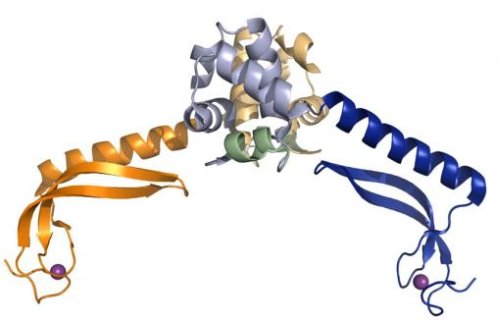Research provides new leads in the case against drug-resistant biofilms
Research provides new leads in the case against drug-resistant biofilms
Films of bacteria that form around foreign materials in the body can be very difficult to defeat with drugs, but research led by Brown University biologists has identified a couple proteins that play a key role in building these “biofilms.” This pair could prove to be a very important target for developing new antibiotics to fight infections.

Bird of Prey Wings of the MqsA, each stabilized by zinc on the wing tip, may control the growth of cells that support biofilms, which are resistant to antibiotics. Credit: Page Lab/Brown University
PROVIDENCE, R.I. [Brown University] — When a foreign object such as a catheter enters the body, bacteria may not only invade it but also organize into a slick coating — a biofilm — that is highly resistant to antibiotics. Like sophisticated organized crime rings, biofilms cannot be defeated by a basic approach of conventional means. Instead doctors and drug developers need sophisticated new intelligence that reveals the key players in the network and how they operate. New research led by biologists at Brown University provides exactly that dossier on some key proteins in the iconic bacterium E. coli.
In a paper published this week in the Journal of Biological Chemistry, the researchers describe a couple of prime suspect genes and the “toxin-antitoxin” protein pair they produce. By analyzing the structure and binding of the proteins in the exquisite detail of atomic-scale X-ray crystallography, the team at Brown and Texas A&M University makes the case that “MqsR” and “MqsA” proteins are important operators worth targeting in hopes of disrupting the formation of biofilms.
“Developing new antibiotics has been very difficult, and they all pretty much target the same few proteins,” said corresponding author Rebecca Page, assistant professor of molecular biology, cell biology and biochemistry at Brown. “Our proteins belong to a family of proteins that have never been investigated for their ability to lead to novel sets of antibiotics. This really provides a new avenue.”
The main role of the combination, or complex, of MqsA and MqsR is that they appear to control the transcription of many genes, including ones that govern the growth of “persister” cells, which provide biofilms with a mesh of antibiotic-resistant constituents. In normal populations, persisters are one in a million. In biofilms, they are one in a hundred.
“The MqsR:MqsA complex not only binds its own genetic promoter, but also binds and regulates the promoters of other genes that are important for biofilm formation,” Page said. “This is the only known toxin-antitoxin system that is capable of doing this.”
The MqsA antitoxin protein can clamp DNA in its “wings.”
Credit: Page Lab/Brown University
An odd bird
The MqsA antitoxin is as unusual as it is influential, Page’s team reports. For one thing, the protein, which resembles a bird with wide flapping wings — Page likens it to a Klingon “Bird of Prey” ship from Star Trek — needs the metal zinc on each wing tip to keep it stable. When it’s bound to its partner toxin and DNA, the antitoxin also keeps a very tight lid on the toxin’s ability to operate on mRNA, squeezing key parts, or active sites, so close together (about 1 billionth of a meter) that the mRNA simply can’t enter.
Because the toxin’s activity is key to the health and welfare of persister and biofilm cells, the properties of the toxin-antitoxin binding that regulate them give rise to some potential drug development strategies, Page said. For most of the time, the toxin is bound by the antitoxin, allowing cells to grow. Under other conditions, the antitoxin is destroyed and the toxin is free to cleave, or disable, mRNA. That shuts off existing persister and biofilm cells from further growth, and instead keeps them in a dormant state well-protected from things like antibiotics. If that cleaving goes on too long, however, the cells will die.
So two approaches for drug development, Page said, might be to find compounds that can either keep the toxin-antitoxin pair associated all the time (so that the toxin is inactive and thus that no cleaving occurs), or keep them separated all the time (so that the toxin is active and cleaving always occurs). The zinc on the antitoxin may also prove to be a target.
The investigation is ongoing, but the word is now out on the street that for MqsA and MqsR, the heat is on.
In addition to Page, the paper’s other authors are graduate student Breann Brown and Associate Professor Wolfgang Peti in Brown’s Department of Molecular Pharmacology, Physiology, and Biotechnology, and Thomas Wood, professor of chemical engineering at Texas A&M.
* The above story is reprinted from materials provided by Brown University
** More information at Brown University (Providence, Rhode Island, USA)




















